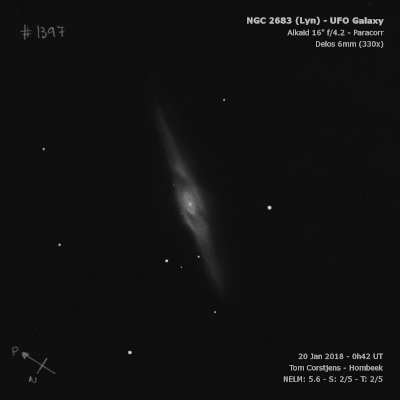
William Herschel discovered NGC 2683 = H I-200 = h532 on 5 Feb 1788 (sweep 807) and reported "very brilliant, mE from sp to nf but nearer the meridian, about 7 or 8' l and 2 1/2 or 3' br. The brightness also much elongated and going off pretty suddently; a beautiful object." A total of 16 observations were made at Birr Castle and several times it was described as slightly concave and sharper on the preceding side. On 2 Jan 1868, "vF streaks and lanes on each side parallel to ray [were suspected]."
300/350mm - 13.1" (1/18/85): very bright, very large, nearly edge-on 4:1 SW-NE, 8.0'x2.0', halo is broadly concentrated. Mottled or dusty near the core but no distinct nucleus.
16x80 (1/18/85): visible in finder as a faint, edge-on steak
13.1" (2/25/84): bright and impressive, brigter core, thin fainter extensions oriented SW-NE.
400/500mm - 18" (3/13/10): gorgeous view at 280x! This detailed, edge-on spiral extends 9'x1.5' SW-NE. The central region is well concentrated with a very bright, elongated core, roughly 3'x1.5' and noticeably mottled or dusty with brighter knots or spots near the core. The southwest extension is more prominent and was easily traced to the outer tip. It broadly increased in brightness to the core. In contrast, the northeast extension faded rapidly after the core. The northeast arm had a low surface brightness as it extended past a mag 13 star (close double) off the north flank. Overall, the galaxy presents an unusual warped appearance with the southwest and northeast extensions not aligned in position angle.
Notes by Steve Gottlieb